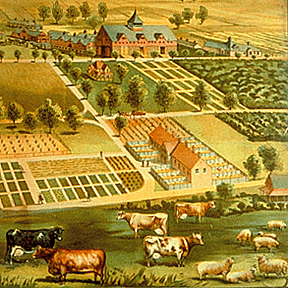Introduction
The Central Experimental Farm in Ottawa is an exceptional example of a 19th-century landscape that demonstrates the vitality of Canadian science in general and agricultural science in particular from the late Victorian Period onward. Created in 1886, it was explicitly designed to serve as the showpiece for Canada's scientific and agricultural ambitions within the Empire and within North America.

[Source: AAFC, neg. 445099]
Experimental Farms, astronomical observatory campuses, zoos, botanical gardens and museums endure throughout Europe, North America, India, Australia and New Zealand as evidence of the importance of science to the public and governments in the Victorian era. In Canada the most prominent scientific landscapes were open books into a world where the collection and dissemination of scientific knowledge was consciously and successfully harnessed to nation-building. Despite their historical and cultural importance, however, many of these landscapes have disappeared with urban and rural redevelopment or have been so modified that their original power is no longer legible.
The Central Experimental Farm is an exception to this tendency. Since its founding, its surroundings have changed dramatically from a predominantly rural landscape to a complex inner city one. But within this shifting context, the Farm itself has survived surprisingly intact. Its physical form and functional character have been largely sustained, and so has its power to inform and to delight. This is due in part to its extraordinary size - over 400 hectares - and to the continuing logic of its original design. The intricate patterns of scientific activity are still expressed in its landscape, buildings, collections and research programs.

In recent years, the Central Experimental Farm has been subject to a diverse set of pressures and expectations. It has begun to take on a variety of identities - sometimes competing identities - and this has begun to cause confusion about its future and even its long-term survival.
This Management Plan has been prepared in response to these uncertainties. It articulates the Farm's values and proposes an appropriate future to protect and enhance them. The process of developing the Management Plan has been one of exploration, debate, and consensus-building. This process will continue in its implementation. The dynamic context of a cultural landscape based on evolving relationships between land, community and science demands it. In framing this plan, AAFC expressly intends to ground future dialogues in a shared vision and understanding.